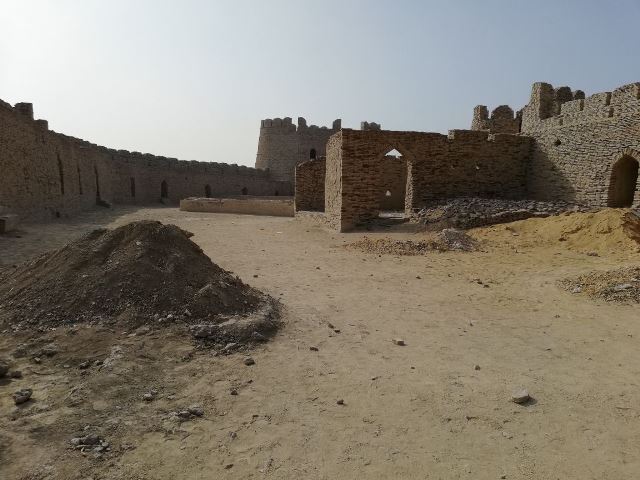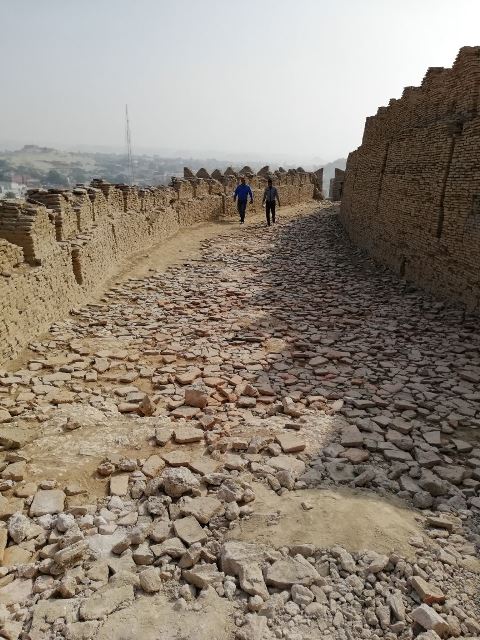Hithchiker
MEMBER
https://tribune.com.pk/story/1591615/1-fort-kot-diji-discarded-jewel-heart-sindh/
THE EXPRESS TRIBUNE > PAKISTAN
Fort of Kot Diji, a discarded jewel in the heart of Sindh
SHARE TWEET
Fort of Kot Diji, a discarded jewel in the heart of Sindh
By Riazul Haq
Published: December 24, 2017
15SHARES
SHARE TWEET EMAIL

PHOTO:EXPRESS
KHAIRPUR: One of the victims of the much-hyped devolution post-18th amendment is cultural heritage. The subject may not seem important enough for decision-makers to dwell upon, but a single glimpse of these invaluable relics tells that they are screaming for attention.
The Fort of Kot Diji, a glory of the past built in the heart of Sindh – Khairpur – is in ruins and nobody bothers to even talk about it, maybe because it is not the top priority or will ever be.
A visit to this epic masterpiece of the Talpur dynasty shows a sadistic picture which triggers feelings of gloominess and gives a prime example of how a state’s neglect can cost the nation to this extent.

Restoration of Kot Diji Fort planned
The fort was built in 1785 by Mir Sohrab Khan Talpur, also the founder of the Kingdom in northern Sindh. The fort is situated in the Kot Diji town which is a few miles east of the Indus River and at the edge of Nara-Rajasthan desert.
At the entrance of the main gate to the fort, a drug addict is begging for a few rupees and a middle-aged man is selling plastic toys on his wooden cart. “A few years back there used to be traditional dresses and replicas of antiques but now the number of visitors to the fort has gone down so nothing sells here,” said a local shopkeeper, sitting in his shop a few yards away.
The entrance to the main 18 feet gate is through a small four feet gate. Both the gates have huge (two feet) pointed edges made of iron probably to stop elephants as during the era when the fort was built elephants were used in war.

The plaque inside the fort reads that it was constructed on a limestone hill with kiln-baked bricks. The hill is about 110 feet high and the fort has walls 30 feet higher. It has three strategically placed towers about 50 feet tall.
The fort is divided by three elephant-proof gates into as many overlapping levels with walls segmenting about 50 bastions and an 18 kilometres boundary wall, easily witnessed from the highway. All the walls and bastions have arrow-slits allowing defenders to attack their enemy from a decent height.
Mine Caves In: Four workers die in Kot Diji
Besides the bastions and towers, an ammunition depot, water reservoir, the harem, probably for Mir(s), a prison, a place for holding court and cells for accommodation of guards and sepoys are also part of the fort.
The fort was never attacked due to its strategic location and well-planned construction, but the march of aging, coupled with the apathy of the Sindh and federal governments, has aged the beautiful building.
Before devolution, the federal government had the possession of this fort while in 2011 it was handed over to the Sindh province as part of the devolution of Ministry of Culture.
Scattered and broken bricks, deteriorating bastions, and absence of caretakers or anyone from the management tells the tale of the colossal neglect.
Altaf Aseem is a member of the consultative committee on Mohen-jo-Daro and a former anthropology teacher at Shah Abdul Latif University Khairpur. He lamented that in 2007 when the then minister for culture arrived at the fort and asked him how much had been allocated in this budget for the fort, the reply that Rs5,000 had been allocated for the renovation and conservation, surprised him.
In the same breath, he said, “The Sindh government, after 2011, could have done better.”
Another aspect he highlighted is that the government gives renovation work to contractors with no experience of handling and working on such buildings which spoils the existing vibes.
THE EXPRESS TRIBUNE > PAKISTAN
Fort of Kot Diji, a discarded jewel in the heart of Sindh
SHARE TWEET
Fort of Kot Diji, a discarded jewel in the heart of Sindh
By Riazul Haq
Published: December 24, 2017
15SHARES
SHARE TWEET EMAIL

PHOTO:EXPRESS
KHAIRPUR: One of the victims of the much-hyped devolution post-18th amendment is cultural heritage. The subject may not seem important enough for decision-makers to dwell upon, but a single glimpse of these invaluable relics tells that they are screaming for attention.
The Fort of Kot Diji, a glory of the past built in the heart of Sindh – Khairpur – is in ruins and nobody bothers to even talk about it, maybe because it is not the top priority or will ever be.
A visit to this epic masterpiece of the Talpur dynasty shows a sadistic picture which triggers feelings of gloominess and gives a prime example of how a state’s neglect can cost the nation to this extent.

Restoration of Kot Diji Fort planned
The fort was built in 1785 by Mir Sohrab Khan Talpur, also the founder of the Kingdom in northern Sindh. The fort is situated in the Kot Diji town which is a few miles east of the Indus River and at the edge of Nara-Rajasthan desert.
At the entrance of the main gate to the fort, a drug addict is begging for a few rupees and a middle-aged man is selling plastic toys on his wooden cart. “A few years back there used to be traditional dresses and replicas of antiques but now the number of visitors to the fort has gone down so nothing sells here,” said a local shopkeeper, sitting in his shop a few yards away.
The entrance to the main 18 feet gate is through a small four feet gate. Both the gates have huge (two feet) pointed edges made of iron probably to stop elephants as during the era when the fort was built elephants were used in war.

The plaque inside the fort reads that it was constructed on a limestone hill with kiln-baked bricks. The hill is about 110 feet high and the fort has walls 30 feet higher. It has three strategically placed towers about 50 feet tall.
The fort is divided by three elephant-proof gates into as many overlapping levels with walls segmenting about 50 bastions and an 18 kilometres boundary wall, easily witnessed from the highway. All the walls and bastions have arrow-slits allowing defenders to attack their enemy from a decent height.
Mine Caves In: Four workers die in Kot Diji
Besides the bastions and towers, an ammunition depot, water reservoir, the harem, probably for Mir(s), a prison, a place for holding court and cells for accommodation of guards and sepoys are also part of the fort.
The fort was never attacked due to its strategic location and well-planned construction, but the march of aging, coupled with the apathy of the Sindh and federal governments, has aged the beautiful building.
Before devolution, the federal government had the possession of this fort while in 2011 it was handed over to the Sindh province as part of the devolution of Ministry of Culture.
Scattered and broken bricks, deteriorating bastions, and absence of caretakers or anyone from the management tells the tale of the colossal neglect.
Altaf Aseem is a member of the consultative committee on Mohen-jo-Daro and a former anthropology teacher at Shah Abdul Latif University Khairpur. He lamented that in 2007 when the then minister for culture arrived at the fort and asked him how much had been allocated in this budget for the fort, the reply that Rs5,000 had been allocated for the renovation and conservation, surprised him.
In the same breath, he said, “The Sindh government, after 2011, could have done better.”
Another aspect he highlighted is that the government gives renovation work to contractors with no experience of handling and working on such buildings which spoils the existing vibes.
